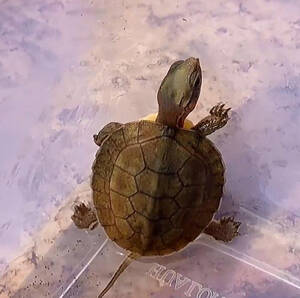Mauremys sinensis
IUCN
LCBasic Information
Scientific classification
- name:Mauremys sinensis
- Scientific Name:Mauremys sinensis,Chinese Stripe-necked Turtle,Ocadia sinensis Gray,1834,Chinese turtle, spotted turtle, pearl turtle, long-tailed turtle, Taiwan turtle
- Outline:Testudines
- Family:Testudinata Testudinidae Pseudoterra
Vital signs
- length:118-246mm
- Weight:380-4500g
- lifetime:50years
Feature
The head is small, with a tapered snout that protrudes beyond the tip of the beak.
Distribution and Habitat
In China, it is distributed in Guangdong, Guangxi, Hainan, Jiangxi, and Taiwan. Abroad, it is distributed in Laos and Vietnam.
It lives in ponds, rice fields, and slow-flowing waters.
Appearance
The head is relatively small, the back of the head is smooth and scaleless, the carapace is oval, with 3 ridges (obvious in juveniles), and the rear edge is not serrated. The front edge of the plastron is flat, the rear edge is notched, the limbs are flat, the tail is short, and the end is pointed. The back and carapace of the head, neck, limbs, and tail are chestnut black or dark brown; there are 2-3 yellow-green inlaid fine lines on the top of the head, extending to the occipital, and there are more than 4 yellow-green inlaid vertical stripes on the sides of the head and neck. The plastron is brown or light yellow, with large black spots on each shield. There are several yellow-green inlaid vertical stripes on the limbs and tail.
Details
The flower turtle is an aquatic turtle. It is water-loving and has the habit of going ashore to bask in the sun. When the temperature is above 25℃ and the weather is fine and sunny, the flower turtle likes to climb onto the terrace or the shore to bask in the sun. The flower turtle has a wide adaptability and strong vitality. It often lives in small rivers and ponds. It likes to be quiet and will dive to the bottom of the pond when frightened. It has a relatively docile temperament, does not like to fight, and does not bite people.

Flower turtles have the habit of living in groups, usually two people live in a cave together, and sometimes there are 7-8 people in a cave. Flower turtles are cold-blooded animals. They hibernate from November to March of the following year and start to move in April. In the hot season, they rarely move during the day. Under artificial breeding conditions, they hide in caves or places with more aquatic plants during the day, dive into the water when the temperature is high, move frequently in the evening, and like to lie in shallow water at night, stretching their limbs to rest. When the water temperature is below 20℃, they basically do not eat. They only start eating when the temperature reaches 24℃. The peak feeding period is from June to October, with the peak period from July to September. The temperature drops in November, and the feeding gradually decreases until they stop eating and enter hibernation. Flower turtles usually eat from dusk to the next morning. They can eat both animal feed (small fish, shrimp, snails, earthworms, etc.) and plant feed (corn, sweet potato, pumpkin and various aquatic plants, vegetables, etc.).
The reproduction of flower turtles is basically similar to that of general turtles. They can mate and lay eggs when they weigh more than 250 grams. The egg-laying period is from February to June, and 1-3 batches of eggs are laid each year. The eggs are large, oblong, with white, thick and hard shells. The egg has a long diameter of 29.6-47.0 mm, a short diameter of 19.4-27.5 mm, and weighs 6.2-10.0 grams. For artificial incubation of turtle eggs, place the eggs in a sand basin or sand box, with a layer of eggs and a layer of sand on top. Water the sand regularly to keep it moist. Place the basin or box indoors, where the temperature is generally between 28-33℃. The baby turtles will hatch in about 63 days.

There are large differences between male and female flower turtles. Male turtles are smaller than female turtles. Male turtles usually weigh between 380 and 1000 grams, while female turtles can weigh up to 4500 grams. Male turtles have sexual characteristics when their carapace is more than 10 cm. Female turtles have thin and short tails, and the anus is close to the rear edge of the plastron; male turtles have thick and long tails, and the anus is far from the rear edge of the plastron. Under artificial breeding conditions, they mature in about 3 years. As they age, the amount of eggs they lay increases year by year, and the fertilization rate increases.
Listed in China's "National Key Protected Wildlife List" (February 5, 2021) at level 2.








